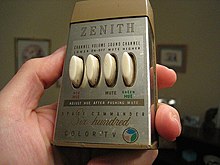Robert Adler
Robert Adler (December 4, 1913 – February 15, 2007) was an Austrian-born American inventor who held numerous patents.
Contents[hide]
|
Achievements
Adler was born in Vienna in 1913. He earned a Ph.D. in Physics from the University of Vienna in 1937. After emigrating to the United States, he began working at Zenith Electronics in the research division in 1941. In his lifetime, Adler was granted 58 USpatents.
Contributions to the remote control
The invention Adler is best known for is the wireless remote control for televisions. While not the first remote control, its underlying technology was a vast improvement over previous remote control systems.
The "Flashmatic" remote control, invented by Eugene Polley, another engineer at Zenith, was the first wireless remote control, replacing the signal cable based remote control devices, which never were a success. The Flashmatic used directional flashlight in the transmitter device, and photo cells in the television set itself. One of the major shortcomings of this technology was that if the television set was exposed to direct sunlight, it could inadvertently trigger one of the remote control functions. The company president sent the engineers back to the drawing board to come up with a better solution.



